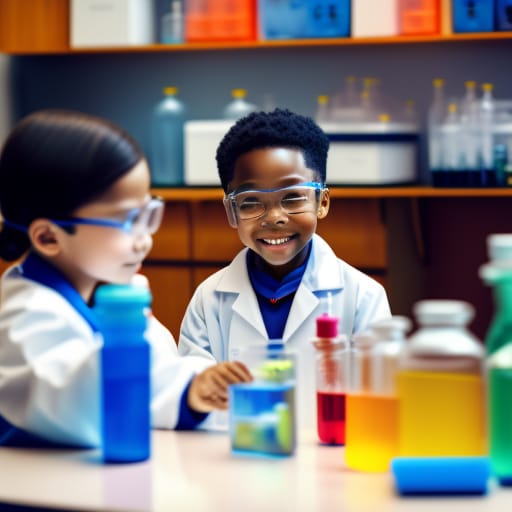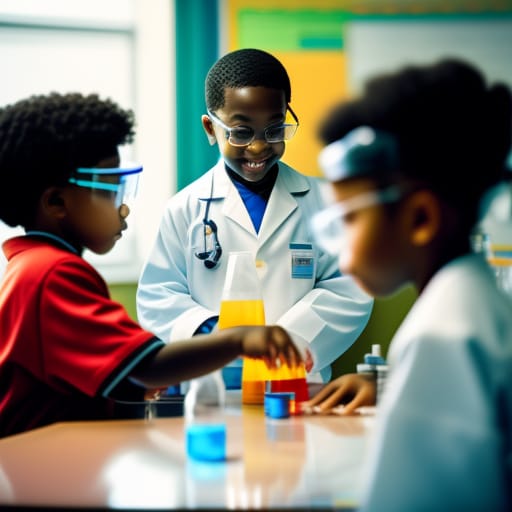Science, technology, engineering, and math (STEM) education is more important than ever in today’s world. Research shows that engaging in hands-on science activities as early as preschool helps spark curiosity and builds critical thinking skills in children. One great way to get kids excited about science is with Little Science Kit.
Little Science Kit provides fun and educational DIY science experiments that can be done at home or in the classroom. The kits are designed specifically for children ages 5-12 and cover topics like chemistry, physics, biology, astronomy, and more.
In this beginner’s guide, we’ll explore what’s included in Little Science Kit, the benefits of hands-on science learning for kids, and how to get the most out of using these kits at home or in school.

What’s Included in Little Science Kit
Each Little Science Kit contains materials for 10-15 engaging science experiments that teach core STEM concepts through hands-on learning. Here’s an overview of what you’ll find inside:
- Lab supplies – plastic beakers, test tubes, petri dishes, pipettes, goggles, and other essential lab gear
- Chemicals and reagents – baking soda, citric acid, yeast, vegetable oil, food coloring, etc.
- Specialized scientific tools – microscope, magnifying glass, mini telescope, magnets, prisms
- How-to guides – step-by-step instructions for each experiment
- Education booklet – explains the science behind every experiment
Kits are available for different science subjects:
- Chemistry Kit – Acids & bases, chemical reactions
- Physics Kit – Forces, energy, light, gravity
- Biology Kit – Cells, microbes, plants, ecosystems
- Astronomy Kit – Solar system, stars, telescopes
There are even kits for younger kids ages 3-6 tailored to early STEM learning.
Benefits of Hands-On Science Learning
Research shows that kids learn better through hands-on experiential learning compared to traditional lecture-based instruction. Here are some of the top benefits of doing science experiments:
- Engagement – Firsthand experiences make science exciting and interest kids in STEM.
- Deep understanding – Active participation creates deeper comprehension vs passive learning.
- Problem-solving – Experiments teach critical thinking, troubleshooting, and analysis.
- Collaboration – Group projects promote teamwork, communication and social skills.
- STEM skills – Kids develop science process skills like observing, measuring, and recording data.
- Confidence – Hands-on successes give kids confidence in STEM subjects.
Hands-on science stimulates curiosity, motivation to learn, and skills that benefit kids in and out of the classroom.
Getting Started with Little Science Kit
Little Science Kit makes it easy to set up exciting science experiments at home or school. Here are some tips to get started:
- Review experiments – Read through activity guides to prepare materials and understand procedures.
- Set up a workspace – Clear a table or work area and lay out all needed supplies.
- Follow all safety rules – Have kids wear goggles and follow safe handling instructions.
- Supervise closely – Remain actively engaged to assist and answer questions.
- Encourage engagement – Ask open-ended questions and let kids make observations.
- Clean up properly – Model good lab cleanliness and waste disposal.
- Discuss results – Talk about the science behind the experiments and what was learned.
With close adult supervision, even young children can successfully participate in hands-on science activities with Little Science Kit.
Top Experiments for Kids
Little Science Kit provides an array of fun experiments that teach core science concepts. Here are 5 great experiments to try with kids:
1. Make Your Own Bouncy Ball
This chemistry experiment has kids mix household ingredients to produce bouncy balls. They’ll learn about chemical reactions and states of matter.
Supplies: Borax powder, white glue, food coloring, water
Procedure:
- Mix borax powder and water in a bowl.
- In a plastic cup, mix glue, food coloring, and borax solution.
- After forming a ball, remove from liquid and knead until no longer sticky.
- Bounce ball to observe elastic properties.
Science Concepts: Polymers, chemical bonding
2. Make a Microscope
Transform a basic magnifying glass into a microscope using household items. Kids will learn how microscopes magnify tiny objects.
Supplies: magnifying glass, plastic bottle, tape
Procedure:
- Remove the bottom of the plastic bottle.
- Tape the magnifying glass to the mouth of the bottle, curved side down.
- Place the sample on the stage and observe under magnification.
Science Concepts: Optics, magnification
3. Make a Telescope
With simple lenses and cardboard, kids can build their own refracting telescope. They’ll learn how telescopes use lenses to see faraway objects.
Supplies: 2 convex lenses, cardboard tube, tape
Procedure:
- Insert the eyepiece lens in one end of the cardboard tube.
- Insert objective lens in other ends, 100 cm from the eyepiece.
- Point the telescope at distant objects and look through the eyepiece.
Science Concepts: Refraction, optics
4. Make a Magnifying Glass
By filling a plastic baggie with water, kids can transform it into a magnifying glass. They’ll learn how curved lenses bend and focus light.
Supplies: Clear resealable plastic bag, tape, water
Procedure:
- Fill bag halfway with water and seal tightly.
- Tape bag to sunny window with water bulge outward.
- Move paper under the bag and observe magnification.
Science Concepts: Refraction, convex lenses
5. Make a Lava Lamp
This classic experiment combines oil, water, and fizzy tablets to make a colorful glowing lamp. Kids learn about density and chemical reactions.
Supplies: Vegetable oil, water, food coloring tablet, Alka-Seltzer
Procedure:
- Fill bottle 1/3 with water and several drops food coloring.
- Fill bottle with vegetable oil until almost full.
- Drop in 1/2 Alka-Seltzer tablet and watch bubbles form.
Science Concepts: Density, chemical reactions
With just a few basic supplies, kids can explore key science concepts with these easy and engaging experiments. The hands-on learning process will both educate and fascinate kids!

Doing Science Experiments at Home
Doing DIY science projects at home with Little Science Kit provides fun family bonding time and enriches kids’ STEM education. Here are some tips for parents doing at-home science:
- Set up experiments in the kitchen or garage for easy clean up
- Cover tables, wear goggles and aprons to stay clean
- Read instructions together and watch videos to prepare
- Discuss safety rules – no eating or drinking chemicals
- Ask your child open-ended questions to keep them engaged
- Let kids take the lead while you supervise closely
- Take pictures and videos to document the experience
- Talk about what was learned after finishing the experiment
At-home science time gives kids hands-on learning experiences and strengthens interest in STEM fields.
Using Little Science Kit in the Classroom
Little Science Kit offers an excellent way for teachers to add exciting hands-on science activities to their curriculum. Here’s how to integrate it into the classroom:
- Do demonstrations to introduce concepts before student experiments
- Break students into small groups and assign roles – materials manager, data recorder, etc.
- Structure experiments as stations and have groups rotate through
- Set up experiments over multiple class periods for more complex procedures
- Develop custom student lab sheets to record observations and data
- Have students take pictures and videos for multimedia lab reports
- Use experiments to complement textbook lessons and reinforce concepts
- Align activities to national science teaching standards (NGSS)
With thoughtful classroom implementation, Little Science Kit transforms textbook material into engaging hands-on learning experiences that develop science skills.
Challenges of Hands-On Science Learning
While hands-on science has many benefits, introducing it in the classroom can also pose challenges including:
- Preparation time – Experiments require advance planning, set-up, and clean-up
- Cost – Consumable lab supplies must be replenished
- Safety – Close supervision is needed to prevent accidents
- Classroom management – Teachers must maintain order and focus
- Standards alignment – Activities should tie into the required curriculum
- Assessment – Outcomes must be measured beyond hands-on engagement
With proper precautions and commitment to integration, the rewards of hands-on science outweigh the challenges.
Next Steps for Fostering a Love of Science
Doing experiments with Little Science Kit is a great starting point to spark kids’ passion for science. Here are some suggested next steps:
- Visit science museums and events like Maker Faires to inspire innovation.
- Read or watch biographies of great scientists to appreciate their work.
- Join science clubs, competitions, and summer STEM programs.
- Volunteer or intern at science organizations, labs, nature centers etc.
- Start a home science lab to conduct independent experiments.
- Make science a daily habit by noticing scientific phenomena in everyday life.
Exposing kids to the wonder of science at an early age can shape their future careers and positively impact society.

Conclusion: Why Little Science Kit Matters
This beginner’s guide provided an overview of Little Science Kit and the immense value of hands-on science learning for children. These kits empower kids to actively engage in the scientific process with fun, enriching activities that promote critical thinking.
Beyond just doing cool experiments, Little Science Kit equips kids with essential STEM skills and curiosity that benefit them inside and outside the classroom. Parents and educators alike should leverage these kits to plant the seeds of innovation that can blossom into society-changing contributions.
So help our next generation of leaders unlock their inner Einstein with the proven power of hands-on science education!
Frequently Asked Questions
What are the benefits of Little Science Kit for kids?
Little Science Kit provides engaging hands-on science activities that promote curiosity, critical thinking, and STEM skills in kids. The kits make learning core science concepts like chemistry, physics, and biology fun through interactive experiments that spark deep comprehension and interest in STEM fields.
What age range is Little Science Kit appropriate for?
Little Science Kit offers kits suitable for kids ages 3-12. The experiments are tailored for different age levels, with kits for early STEM learning (ages 3-6), elementary school (ages 5-9), and middle school (ages 10-12). With close adult supervision, even young children can successfully participate.
What subjects does Little Science Kit cover?
Kits cover the major science disciplines: chemistry, physics, biology, astronomy, engineering, and more. From chemical reactions to optics to plant biology, kids gain exposure to diverse science curriculum topics through hands-on activities.
What supplies are needed for the experiments?
Each kit is packaged with all the specialized lab supplies and scientific tools needed for the included experiments, aside from basic household items. Things like plastic beakers, magnifying glasses, lab coats, and science reagents are provided.
How can I integrate Little Science Kit into homeschooling or classroom teaching?
The kits can be used as stand-alone at-home science projects or incorporated into classroom lessons. Teachers can do demonstrations, structure experiments in stations, develop custom lab sheets, and have students create multimedia lab reports. Activities align to national science teaching standards.